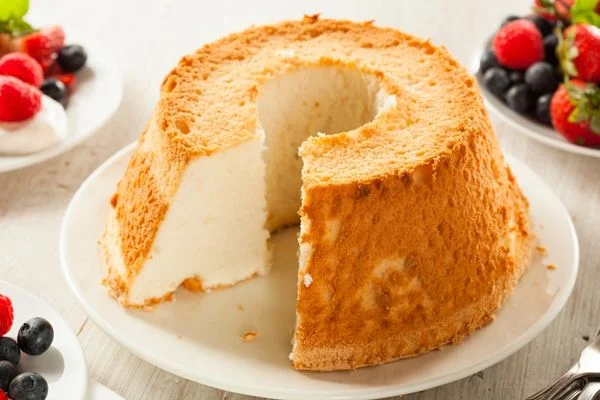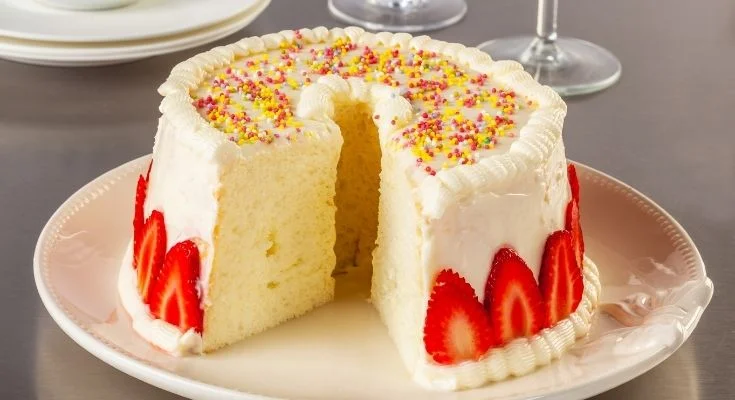Angel Food Cake: A Slice of History and Helpful Tips for Baking Bliss
Ah, angel food cake – the name itself conjures images of light, fluffy clouds, and a dessert as heavenly as its name suggests. But this ethereal treat boasts more than just a delightful taste and texture.
Its history is surprisingly rich, and baking it requires a touch of both art and science. So, grab a cup of tea, settle in, and let’s delve into the fascinating world of angel food cake!
Light and fluffy textured angel food cake is one kind of sponge cake. The delicious Angel food cake, also called ice cream cake is originated in the early 1800s in America. It became popular in the early 2000s.
You can easily make an Angel cake with stiffly beaten egg whites, flour, and sugar. Cream of tartar is the most common whipping agent that is used to bake angel food cake. During cooking time of this sponge cake, it needs a delicate balance of ingredients, temperature and techniques.
History of Angel Food Cake
American author Lettice Pierce Bryan published the first angle food cake recipe in his “The Kentucky Housewife” cookbook guide In 1839. This cookbook is considered as the first invention of no butter modern angel food cake formula.
After that, in 1878, Isabella Stewart contained the first recipe for the Angel’s cake in her The Home Messenger Book of Tested Recipes (2nd ed.)
A lots of labor and strong beating arm are required whipping the air into the egg whites during making angel food cake. For this reason, some historian agreed that South African American slaves baked this cake for the time.
In every year, National Angel Food Cake Day is being celebrated on October 10. This is one of the best fun food holidays that is a great day to bake a angel cake. We didn’t find any document to confirming about this national day.
Where and when did angel food cake originate?
The exact origins of angel food cake are a bit of a mystery, but its story unfolds in the United States around the late 19th century.
Some historians believe it evolved from earlier sponge cake recipes, with the first known mention of a similar cake appearing in Lettice Bryan’s “The Kentucky Housewife” cookbook in 1839.

However, the first recipe specifically named “Angel’s Food Cake” surfaced in “The Home Messenger Book of Tested Recipes” by Isabella Stewart in 1878. Another recipe for “angel cake” appeared in the prestigious “Boston Cooking School Cook Book” in 1884, solidifying its place in American baking traditions.
The meaning behind the name:
The angelic moniker perfectly captures the cake’s ethereal qualities. Its pristine white color, light and airy texture, and delicate sweetness evoke a sense of pure goodness, fitting its heavenly name.
The Origins of Angel Food Cake
The origins of angel food cake are somewhat unclear, but it is believed to have originated in the United States during the 1800s.
Some sources claim that the cake was first created by African American slaves who were not allowed to use the butter and egg yolks typically found in traditional cakes. Instead, they used the leftover egg whites to make this lighter version of a cake.
The Evolution of Angel Food Cake
Angel food cake began to gain popularity in the United States in the early 1900s. This was due in part to the introduction of baking powder, which allowed bakers to make the cake rise without the need for butter or egg yolks.
In the 1920s, the invention of the electric mixer made it easier to whip egg whites to the necessary consistency, further increasing the popularity of angel food cake.
The Rise in Popularity of Angel Food Cake
Angel food cake rose to popularity in the early 1900s due to its lighter, healthier qualities. It was seen as a dessert that could be enjoyed without guilt, as it contained fewer calories than traditional cakes.
The rise in popularity of angel food cake also coincided with the rise of the women’s suffrage movement, as women began to take more of a role in the kitchen and were looking for new and innovative recipes to try.
Angel Food Cake in the United States
Angel food cake has long been a favorite dessert in the United States. It is often served at special occasions such as birthdays, weddings, and holidays.
In fact, it was declared the official cake of the state of Minnesota in 2017. Angel food cake is also a popular ingredient in other desserts, such as trifles and parfaits.
Angel Food Cake in Other Countries
While angel food cake is most closely associated with the United States, it is also enjoyed in other countries around the world.
In Japan, for example, angel food cake is known as “castella cake“ and is made with honey instead of sugar.
In the Philippines, it is often topped with grated cheese or served with a side of fresh fruit.
In the UK, angel food cake is called “Victoria sponge” and is often filled with jam and whipped cream.
Variations of Angel Food Cake
While the traditional angel food cake recipe is simple, there are many variations that can be made to change the flavor or texture.
Some bakers add cocoa powder to make a chocolate angel food cake, while others add lemon zest for a citrusy twist.
Some recipes call for the addition of cream cheese to create a denser, richer cake.
Frequently Asked Questions:
While cream of tartar helps stabilize the egg whites, it is possible to make angel food cake without it. Lemon juice or white vinegar can be used as a substitute.
While sugar substitutes can be used in some baking recipes, they are not recommended for angel food cake as the sugar is necessary for the cake to rise properly.
Conclusion
Angel food cake has a rich history that dates back to the 1800s. Its light, airy texture and sweet flavor have made it a beloved dessert around the world. Whether enjoyed on its own or used as a base for other desserts, angel food cake is a classic dessert that is sure to please.
